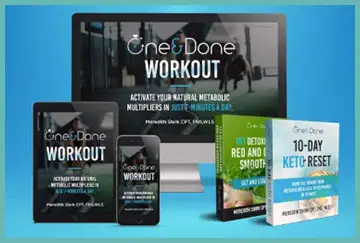I’m not here to sell you on the One and Done Workout. Instead, I’m sharing my unfiltered experience with this program to help you decide if it’s worth your time and money.
Created by Meredith Shirk, this 7-minute Sprint Interval Training (SIT) program promises big results with minimal effort. But with mixed reviews floating around online, I approached it with skepticism.
After trying it myself, I’ve got plenty to say about what works, what doesn’t, and whether it’s a scam or a legitimate fitness option. Let’s get into it.
My Experience With One And Done Workout
When I first stumbled across the One and Done Workout, I was intrigued by the idea of getting fit in just seven minutes a day. As a busy professional with two kids and a packed schedule, the thought of squeezing in a quick workout without needing a gym or fancy equipment was appealing.

I purchased the program for $29, expecting a straightforward, no-nonsense fitness plan. What I got was a digital dashboard with high-definition videos, a PDF manual, and some bonus content like smoothie recipes and a keto meal plan.
The setup was simple enough. Each session starts with a brief warm-up, followed by three 20-second bursts of high-intensity exercises, with active recovery periods in between, and ends with a cool-down.
Meredith Shirk, the creator, guides you through each move with clear instructions, which I appreciated as someone who’s not a fitness guru. The exercises, like bodyweight squats and modified push-ups, were accessible, and I could do them in my living room without much space. I started at the beginner level, which felt manageable, even with my creaky knees from an old injury.
For the first week, I was motivated. The short duration meant I had no excuse to skip it, and I felt a slight energy boost after each session. By week two, though, I noticed my enthusiasm waning. The workouts, while quick, didn’t feel as transformative as the marketing suggested. I didn’t see the promised “fat-melting” results, and my weight stayed stubbornly the same.
The constant barrage of promotional emails from Svelte Training, pushing additional products, also started to grate on me. It felt less like support and more like a sales pitch. While the program wasn’t hard to follow, it didn’t live up to the hype for me, leaving me questioning its value.
Read More: My Thoughts On Orangetheory Vs. Life Time Fitness
Pros Of One And Done Workout
- Time-efficient design: The 7-minute workouts are a godsend if you’re juggling a hectic schedule. You can squeeze them in during a lunch break or before the kids wake up, making it easier to stick with than hour-long gym sessions.
- No equipment needed: I loved that I didn’t need to buy weights or a treadmill. The program uses your body weight for resistance, so you can do it anywhere—your living room, a hotel room, or even a tiny apartment.
- Beginner-friendly modifications: Meredith includes options for different fitness levels, which was a relief for someone like me with joint issues. If you can’t do a full push-up, there’s a modified version that still gets your heart pumping without killing your knees.
- Clear video guidance: The high-definition videos are a standout. Meredith demonstrates each move, so you’re not left guessing about form. This made it easier to follow along, especially for someone who’s not a fitness pro.
- Low cost upfront: At $29 for lifetime access, it’s cheaper than a gym membership or most other fitness programs. You get the videos, a manual, and some bonus content, which feels like decent value at first glance.
Cons Of One And Done Workout

- Overhyped results: The program claims you’ll see dramatic changes in two weeks, but I didn’t lose a single pound after a month. The “fat-melting machine” promise feels exaggerated, especially if you’re not pairing it with a strict diet.
- Aggressive upselling: After signing up, I was flooded with emails pushing additional Svelte products. It felt like every other day, I was being nudged to buy supplements or another program, which was annoying and made me question their motives.
- Limited workout variety: The 14-day program cycles through similar exercises, and it got repetitive fast. If you’re someone who gets bored easily, like me, you might struggle to stay engaged beyond the first week.
- Questionable refund process: Several online reviews mention issues with the 60-day money-back guarantee. I didn’t try to get a refund, but horror stories about unauthorized charges and unresponsive support made me wary.
- Not suitable for all conditions: While it’s marketed as adaptable, those with serious health issues, like autoimmune disorders or severe joint problems, might find even the modified exercises too intense. I had to skip some moves because of my knees.
Tips For One And Done Workout

- Consistency is key: If you’re going to stick with this program, make it a daily habit. I found setting a specific time, like right after my morning coffee, helped me stay on track. Missing a day made it easier to skip the next one, so try to do it even if you’re not feeling 100%.
- Pair with a balanced diet: The program doesn’t require dietary changes, but I noticed better energy when I ate more veggies and cut back on junk food. The included smoothie recipes are a good start, but you’ll need to plan meals to see any weight loss.
- Listen to your body: If you’ve got injuries or health conditions, don’t push through pain. I learned to modify moves even more than suggested, like doing wall push-ups instead of floor ones, to avoid aggravating my knees. Consult a doctor if you’re unsure about your limits.
- Mix it up to stay motivated: To combat boredom, I started adding my own stretches or a short walk after the sessions. You can also check out Meredith’s free YouTube videos for extra variety, but be prepared for more sales pitches.
- Manage email overload: The constant emails from Svelte were overwhelming. I set up a filter to send them to a separate folder so I could focus on the workouts without feeling pressured to buy more. You can also unsubscribe, but double-check it won’t affect your program access.
Comparison With Other Brands

Johnson & Johnson 7-Minute Workout
The Johnson & Johnson 7-Minute Workout app is a free alternative that also promises a full-body workout in minimal time. Unlike One and Done, it crams 12 exercises into a single circuit, targeting major muscle groups with moves like jumping jacks and wall sits. I found it more intense but also more varied, keeping me engaged longer. However, it lacks the personalized coaching vibe of Meredith’s videos and doesn’t emphasize the hormonal benefits of SIT. It’s great if you want something free, but you’ll need to do multiple circuits (14-21 minutes) for optimal results, which defeats the “quick” promise for some.
Yoga Wake Up
Yoga Wake Up is an app focused on gentle, wellness-oriented routines, often costing $5.99 a month. It’s less about sweating and more about improving flexibility and mindfulness, which I found refreshing after the high-energy SIT approach of One and Done. It’s not designed for weight loss, so it won’t deliver the fat-burning results Meredith promises. For someone like me with joint issues, its low-impact stretches were easier on my body, but it lacks the cardio punch. If your goal is stress relief over fitness, this might be a better fit.
Essentrics
Essentrics, another program I’ve tried, focuses on dynamic stretching and strengthening, often used by people recovering from injuries. It’s pricier than One and Done, with DVDs or streaming subscriptions costing more than the $29 one-time fee. I liked its fluidity and how it improved my mobility without stressing my joints, but the workouts take 20-30 minutes, which felt less convenient. Essentrics offers more variety and a gentler approach, making it a stronger choice for those with physical limitations, but it’s not as focused on quick calorie burning as One and Done claims to be.
Tabata Protocol
Tabata, a four-minute protocol of eight 20-second high-intensity bursts with 10-second rests, is a close cousin to One and Done’s SIT. It’s often free via YouTube or apps, which makes it more accessible. I found Tabata brutally intense, even compared to One and Done, and it left me gasping for air. However, its brevity means it’s harder to scale for beginners, and improper form can lead to injury. One and Done’s longer recovery periods and guided videos make it safer, but Tabata’s raw intensity might appeal more if you’re already fit and want a challenge.
Read More: My Thoughts On Smart Gym Vs. Fitbod
Frequently Asked Questions (FAQ)
The concept of a 7-minute workout, like One and Done, can provide some benefits, especially for beginners or those short on time. Research supports that short, high-intensity sessions improve cardiorespiratory fitness and burn calories. However, I didn’t see significant weight loss or muscle gains after a month. For noticeable results, you’d likely need to pair it with a solid diet and possibly do multiple circuits, pushing the time closer to 14-21 minutes. It’s a decent start, but don’t expect miracles from seven minutes alone.
For me, One and Done didn’t deliver the weight loss it promised. The SIT approach is backed by science for boosting metabolism, and I felt more energized, but the scale didn’t budge. Online reviews are mixed—some users report losing a few pounds, while others, like me, saw no change. It might help with endurance or energy, but without dietary changes, don’t bank on shedding fat quickly. The marketing overhypes what seven minutes can realistically achieve.
One and Done is a real program created by Meredith Shirk, a certified trainer with a solid fitness background. The workouts are structured and professionally presented, so it’s not a scam in the sense of being fake. However, I found the aggressive upselling and questionable refund experiences reported online concerning. Some users claim they were charged for extras they didn’t agree to, which raises red flags. It’s legit but proceed with caution and read the fine print.
No, One and Done is a one-time payment of $29 for lifetime access to the digital program, including videos and manuals. That’s one of its stronger points—no recurring fees like a gym membership. However, be aware of potential upsells after purchase, as I and others received relentless emails pushing additional products. Always check your bank statements to ensure no unauthorized charges sneak through, as some reviews reported issues with this.
Conclusion: For One and Done Workout
I can’t recommend One and Done Workout with confidence. While the 7-minute format and clear videos are appealing for busy folks, the lack of results, repetitive exercises, and aggressive upselling left me disappointed. There are better, more transparent options out there. Save your money and explore free or low-cost alternatives like the Johnson & Johnson app or YouTube workouts before committing.
